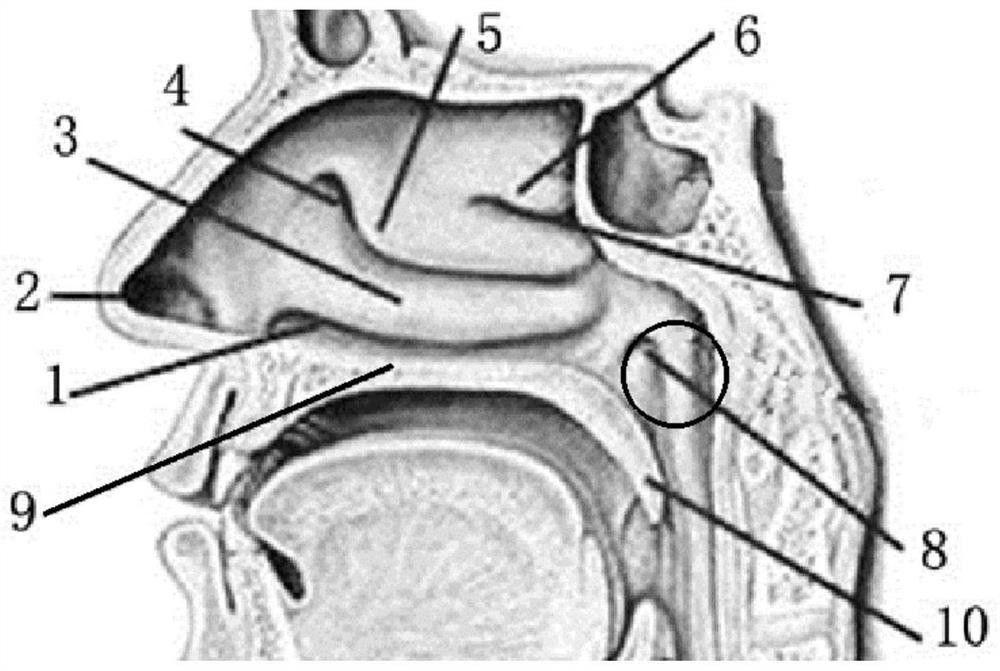Nasopharyngeal swab self-help collection kit
A nasopharyngeal swab and kit technology, which is applied in the field of biomedicine, can solve the problems of insufficient secretion collection amount, insufficient residence time of nasopharyngeal swab, sample collection failure, etc., so as to solve the problem of insufficient secretion collection amount and solution of residence time. Deficiency, the effect of reducing the risk of exposure
- Summary
- Abstract
- Description
- Claims
- Application Information
AI Technical Summary
Problems solved by technology
Method used
Image
Examples
Embodiment 1
[0054] First a brief description of the nasal cavity structure and the sampling process of the prior art: nasal cavity structure see figure 1 The median sagittal section of the nasal cavity shows that there are inferior turbinates 3, middle turbinates 5, and superior turbinates 6 in the nasal cavity, and correspondingly formed inferior nasal passages 1, middle nasal passages 4, and superior nasal passages 7. Among them, the use of nasopharyngeal swabs for sample collection is to insert nasopharyngeal swabs from the lower nasal passage 1. The lower nasal passage 1 is a channel surrounded by the hard palate 9, soft palate 10, and inferior turbinate 3. One end of the lower nasal passage 1 opens in the nose. The vestibule 2 (the opening is called the entrance of the inferior nasal meatus 1 ), and the other end opens into the nasopharynx 8 . The procedure of nasopharyngeal 8 sampling using prior art nasopharyngeal swab is as follows: insert the head of the nasopharyngeal swab into ...
Embodiment 2
[0059] This embodiment is basically the same as Embodiment 1, the difference is that in this embodiment, the nasopharyngeal swab in the prior art has been improved.
[0060] The nasopharyngeal swab self-collection kit of this program includes such as: Figure 5 Shown nasopharyngeal swab, nasopharyngeal swab comprises swab head 11, connecting rod 12 and swab handle 13 three parts. The connecting rod 12 is a hollow cylindrical straight pipe with openings at both ends, and the connecting rod 12 is made of PVC material, which can support and push the swab head 11 through figure 1 The passage in the nasal cavity shown in the figure enters the nasopharynx 8, and the connecting rod 12 made of PVC has certain flexibility and can be slightly bent to adapt to the shape of the passage in the nasal cavity. The swab head 11 includes such as Figure 6 The shown cylindrical tubular central rod 14 with both ends open, the material and diameter of the central rod 14 are consistent with the c...
Embodiment 3
[0066] This embodiment is basically the same as Embodiment 2, and the difference lies in the structure of the swab head 11. In this embodiment, the swab head 11 is curved, such as Figure 8 As shown, the swab head 11 includes a swab head I part 36 and a swab head II part 37, and the angle between them is obtuse. More specifically: the central rod 14 includes an integrally formed rod I part and a rod II part (not shown in the figure), an obtuse angle is formed between the rod I part and the rod II part, and then the center rod 14 with a bend is covered Sponge layer15. When in use, insert the swab head 11 into the lower nasal passage 1 with the swab head I part 36 facing down and the swab head II part 37 perpendicular to the human face. Since the soft palate 10 has a curvature, the swab head 11 is curved so as to better fit the curvature of the soft palate 10 . Compared with the straight swab head 11, this solution can make the swab head 11 go deeper into the nasopharynx 8, an...
PUM
 Login to View More
Login to View More Abstract
Description
Claims
Application Information
 Login to View More
Login to View More - R&D
- Intellectual Property
- Life Sciences
- Materials
- Tech Scout
- Unparalleled Data Quality
- Higher Quality Content
- 60% Fewer Hallucinations
Browse by: Latest US Patents, China's latest patents, Technical Efficacy Thesaurus, Application Domain, Technology Topic, Popular Technical Reports.
© 2025 PatSnap. All rights reserved.Legal|Privacy policy|Modern Slavery Act Transparency Statement|Sitemap|About US| Contact US: help@patsnap.com



